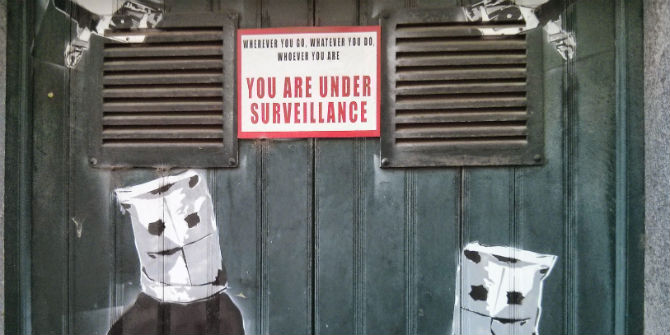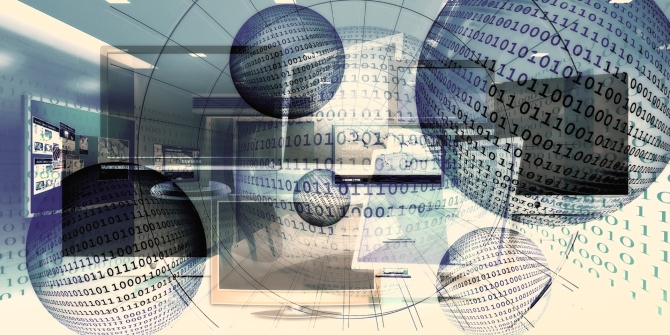 This is the first post in a series on alternative internet(s), following a workshop on the topic at the LSE in September, organised by Mélanie Dulong de Rosnay, Francesca Musiani, Alison Powell and Panayotis Antoniadis. The authors introduce the key topics that will be covered in the series here.
This is the first post in a series on alternative internet(s), following a workshop on the topic at the LSE in September, organised by Mélanie Dulong de Rosnay, Francesca Musiani, Alison Powell and Panayotis Antoniadis. The authors introduce the key topics that will be covered in the series here.
The Internet has been conceived as a distributed, decentralized and self-organized network. However, it is currently being transformed to a highly centralized system dominated by the services offered by big corporations such as Google, Facebook, and Yahoo!, and surveilled by intelligence agencies such as the NSA and GCHQ. This evolution has important implications for both civil liberties, as it affects privacy, security, freedom of expression, and for economic freedoms, as it creates concentration, walled gardens and unbalanced terms of use. Various research and activist projects worldwide try to avoid dependencies on such corporations and offer proposals for an alternative Internet, one which would rely on distributed architectures from infrastructures to services: on community wireless networks, peer-to-peer applications, and distributed online social networks.
This series addresses the concepts and experiments that explore the possibility of such alternative Internets. It builds on a workshop on Alternative Internet(s) which took place at the LSE and examined the techno-politics, architecture frameworks, governance and socio-cultural implications of alternative internet projects. It considers practitioner, activist, and academic perspectives in order to assess the techno-legal feasibility of alternative Internets, understand their design requirements and social implications, and suggest possible ways for improved network governance that would enable a wide diversity of options in order to avoid the concentration of power and single points of failure.
What are “alternative internet(s)”?
The series will cover a wide range of enabling technologies:
- Community wireless networks: built with grassroots, flexible network architecture, providing an alternative ownership structure, free access to the Internet, opportunities for community building and participatory design, and the option for local interactions outside the commercial Internet;
- Peer-to-peer systems and encryption that enable the distributed implementation of otherwise centralized services like searching, storage, content distribution, and accounting and have formed the basis for very successful applications such as BitTorrent for file sharing, Bitcoin for online currencies, and many more;
- Distributed web-based social networks, such as Diaspora and Kune, which allow Internet users to build their own online social networks and organise them according to their individual preferences in terms of privacy and filtering.
Alternative internet(s): ‘media policy by other means’?
Alternatives can help to avoid self-censorship and allow us to express ourselves in the public sphere without fear of algorithmic control and surveillance. However, there are many important decisions to be made, which are subject to a series of trade-offs, ambiguities and contradictions, thus calling for an interdisciplinary treatment. Our goal is to open the dialogue and bring together different perspectives, keeping in mind the need for immediate action; the need for experimenting with alternatives and complements at the technological, social, economic and political level.
That is why this series will call on a wide range of analytic and interdisciplinary perspectives, including:
- Computer science/networking design and architectural choices of alternative platforms and architectures, centralised and decentralised options and their techno-legal consequences:
- The socio-economic impact at the local level, the creation of international communities of practices, the political implications on speech of autonomous platforms and applications, the sustainability of commons-based peer production and the governance of self-organized communities;
- The reflexive effect on media policies, competition law and telecommunication regulation of developing alternative, independent platforms and simultaneously using them to propose alternative political and technical regulation of the networks.
Some of the perspectives in the forthcoming series are from the Scientific committee of the workshop and partners of the project, including:
- Mélanie Dulong de Rosnay (CNRS Institute for Communication Sciences)
- Francesca Musiani (CNRS Institute for Communication Sciences)
- Alison Powell (LSE Department of Media and Communications)
- Panayotis Antoniadis (ETH Zürich)
Our hope is that by the end of this series, we will have all gained a better understanding of the panorama of alternative technologies and how we can use them in constructive ways to address the increasing threats against our privacy and freedom of expression.
The project has been supported by the CNRS (French National Center for Scientific Research) Interdisciplinary Programme on Communication Sciences and part of the project Alternet on Alternative architectures of the internet : risks of network (de)centralisation. Additional support is provided by the Department of Media and Communications at the LSE, the CNRS Institute for Communication Science (ISCC), Paris Sorbonne-Universités, the French National Agency for Research within the frame of the Adam project, and the European Network of Excellence in Internet Science.
This article gives the views of the authors, and does not represent the position of the LSE Media Policy Project blog, nor of the London School of Economics.






Very few people realize that the internet as we know it today based on a 3 layer protocol stack lacks inherent price signals and incentives. That’s because IP was developed as a private, not public, protocol stack. Public networks need settlements. The internet usurped the public PSTN which had built up highly ineffective and counter-competitive access charges and bilateral settlements. Greater work and study is required as to how “balanced settlements” combined with mandated interconnection fosters rapid service creation and investment.
Only then will we see a rapid simultaneous migration to new protocols like IPv6 or other protocol stacks to support 4K VoD, 2-way HD collaboration, mobile first and IoT markets ubiquitously and inexpensively.